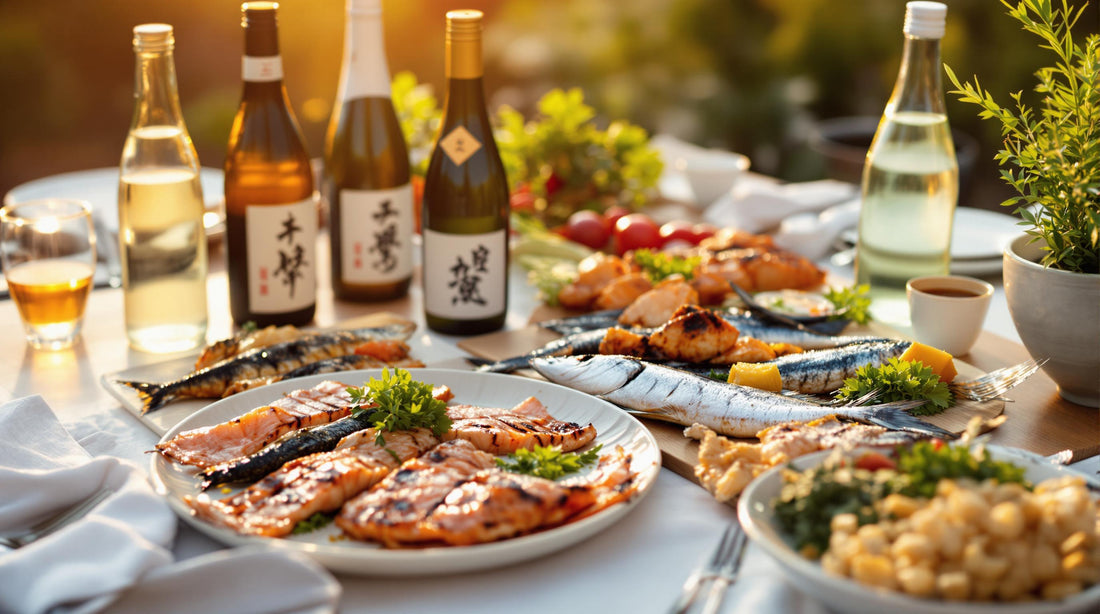
Ultimate Guide to Sake and Grilled Fish
Share
Sake and grilled fish are a perfect match. Why? Sake’s umami and acidity balance the richness of grilled fish while eliminating any fishy smell. This guide simplifies how to pair sake styles with different fish types for a better dining experience.
Key Pairing Tips:
- Light Sakes (Ginjo, Daiginjo): Best for delicate white fish like flounder or sea bream.
- Rich Sakes (Junmai, Kimoto): Pair well with fatty fish like tuna, mackerel, or salmon.
- Creamy Sakes (Nigori): Perfect for spicy or grilled shellfish like scallops.
Quick Pairing Table:
| Fish Type | Recommended Sake Style | Serving Temperature |
|---|---|---|
| White Fish | Ginjo, Daiginjo | Chilled (8-12°C) |
| Fatty Fish | Junmai, Kimoto | Room Temp (15-18°C) |
| Spicy/Grilled Shellfish | Nigori | Chilled (8-12°C) |
Pro Tip: Keep fish seasoning simple (like salt or lemon) to let the sake and fish flavors shine. Experiment with sake temperatures to find your perfect pairing.
Ready to explore more? Let’s dive into the details of sake styles and their ideal matches with grilled fish.
A Guide to Pairing Sake with Seafood
Sake Styles and Their Characteristics
Getting familiar with various sake styles can help you find the perfect match for grilled fish. Each type brings its own flavors and textures to the table, enhancing your meal in unique ways.
Sake Styles for Pairing
Sake offers a range of styles, each suited to different types of grilled fish. Junmai sake has earthy and slightly sweet tones, making it a great choice for richer fish like grilled tuna or mackerel. Ginjo sake, with its fruity and floral notes, pairs wonderfully with the smoky flavors of grilled salmon or miso-marinated black cod. For delicate white fish, Daiginjo sake stands out with its light and complex aromatics. If you're enjoying spicy grilled fish, Nigori sake, with its creamy texture and sweetness, provides a perfect balance.
Factors Affecting Sake Flavor
The flavor of sake is shaped by factors like rice polishing and brewing techniques. For instance, more polished rice results in cleaner, more refined flavors, as seen in the delicate profile of Daiginjo sake [4]. Brewing methods also play a role - styles like Kimoto bring added depth, while regional variations offer unique twists. For example, Hiroshima is known for its fruity sakes, while Niigata specializes in crisp, dry styles that pair beautifully with grilled fish [2].
If you're curious to try these styles, companies like The Sake Company offer curated tasting boxes, complete with pairing recommendations for different fish dishes.
| Sake Style | Key Characteristics | Best Fish Pairings |
|---|---|---|
| Junmai | Earthy, full-bodied, sweet | Grilled tuna, mackerel |
| Ginjo | Fruity, floral, refined | Grilled salmon, black cod |
| Daiginjo | Light, aromatic, complex | Delicate white fish |
| Nigori | Creamy, sweet, textured | Spicy grilled fish dishes |
Pairing Sake with Different Grilled Fish
Pairing sake with grilled fish is all about matching the sake's style to the flavors and textures of the seafood. Here are some combinations that can take your meal to the next level.
Light Sake with White Fish
White fish like sole, flounder, and sea bream work beautifully with lighter sakes that highlight their delicate flavors. Junmai and Ginjo sakes are great choices here. Their clean and subtle profiles enhance the fish's natural taste without overpowering it. For instance, a crisp Junmai from Niigata prefecture pairs wonderfully with minimally seasoned grilled sea bream, letting the fish's sweetness stand out.
The trick is to keep the balance - light sakes complement the gentle smokiness of grilling while preserving the fish's natural flavor. If you're exploring options, The Sake Company's discovery boxes include premium Junmai sakes that are perfect for white fish dishes. For heartier fish, a richer sake style works better.
Rich Sake with Fatty Fish
Fatty fish like salmon, mackerel, and tuna need a bold sake to match their richness. Daiginjo sakes, with their refined profiles, are ideal for cutting through the oils in these fish while enhancing their smoky, grilled flavors. For example, grilled mackerel pairs exceptionally well with Daiginjo sake, which balances the fish's richness and charred edges.
Complex Sake with Shellfish
Grilled shellfish offers a chance to experiment with unique sake pairings. The sweetness and full body of Nigori sake complement the caramelized, briny notes of grilled shellfish like scallops and oysters.
Here’s a quick guide to pairing sake with different shellfish:
| Shellfish Type | Recommended Sake Style | Flavor Harmony |
|---|---|---|
| Grilled Scallops | Nigori | Creamy texture matches the scallops' sweetness |
| Grilled Oysters | Aged Sake | Complex notes balance the oysters' briny flavors |
| Grilled Prawns | Kimoto-Style | Rich umami enhances the smoky, grilled char |
To make these pairings shine, focus on light grilling and simple seasoning. This approach ensures that both the sake and seafood flavors play off each other perfectly, creating a dining experience to remember.
sbb-itb-d9fb1bc
Tips for Successful Pairings
Expert Pairing Advice
Creating great sake and grilled fish combinations comes down to understanding how their flavors work together.
Temperature Makes a Difference: The serving temperature of sake - chilled, room temperature, or slightly warm - can bring out unique flavors that match specific fish types. Choose the right temperature to enhance the pairing.
Think About Fat Content: Pair the richness of the fish with the sake's body. For example, a full-bodied Junmai Kimoto pairs well with rich, fatty fish like tuna or yellowtail.
Seasoning Matters: Keep seasonings simple, like salt or a squeeze of lemon. This enhances the natural flavors of both the fish and the sake without overpowering the pairing.
| Fish Type | Sake Style | Serving Temperature |
|---|---|---|
| White Fish | Ginjo | Chilled (8-12°C) |
| Fatty Fish | Junmai Kimoto | Room Temperature (15-18°C) |
| Pacific Saury | Junmai Classic | Slightly Warm (30-35°C) |
Exploring Premium Sake
The Sake Company offers curated discovery boxes, making it easy to try different sake styles designed for seafood pairings. Their seasonal selections highlight how sake evolves throughout the year, perfectly complementing a variety of fish dishes.
Avoid These Common Mistakes:
- Pairing delicate fish with aged sake can clash with the subtle flavors.
- Over-seasoning fish can disrupt the balance between fish and sake.
- Rich sake might overpower the mild flavors of white fish. [3]
Once you’ve got the basics down, exploring premium sake options can take your dining experience to the next level.
Conclusion and Key Points
Recap of Pairing Basics
Pairing sake with grilled fish is all about creating balance between flavors and intensities. Matching the style of sake to the type of fish can transform a meal into something unforgettable. The trick is to align the sake's body and character with the fish's natural taste and texture.
Sake works beautifully with grilled fish by softening strong aromas and enhancing umami flavors. For delicate white fish, a light Ginjo works best. Meanwhile, richer, fattier fish benefit from full-bodied styles like Junmai Kimoto, which can cut through their richness and balance out any strong aromas.
| Fish Type | Ideal Sake Pairing |
|---|---|
| White Fish | Light Ginjo (clean, crisp) |
| Red Meat Fish | Junmai Kimoto (rich, bold) |
| Silvery Fish | Yamahai (complex, umami-rich) |
Exploring New Pairings
With these basics in mind, you're ready to try out new combinations. While traditional pairing rules are helpful, your personal tastes are just as important in discovering what works best for you.
To take your pairings to the next level, try experimenting with sake temperatures, grilling methods, and seasonal fish. For example, warming sake can bring out its umami-rich notes, while chilled sake emphasizes a crisp, refreshing finish. Adjusting your grilling technique or seasoning can also dramatically shift the pairing experience.
Sake's versatility opens up endless possibilities for pairing with grilled fish. By experimenting and trusting your palate, you’ll uncover combinations that deepen your appreciation for these complementary flavors.
FAQs
What Japanese food goes well with sake?
Sake pairs wonderfully with Japanese cuisine, especially grilled fish. The idea is straightforward: dishes traditionally served with rice often complement sake beautifully.
Here are some popular grilled fish and sake pairings:
| Food Type | Recommended Sake Style | Key Characteristics |
|---|---|---|
| Grilled White Fish | Light Ginjo | Crisp, clean flavors that highlight the fish's delicacy |
| Grilled Fatty Fish | Junmai | A rich, full-bodied option that balances the fish's oiliness |
| Grilled Shellfish | Ginjo | A smooth choice that enhances smoky, briny flavors |
The temperature of sake plays a big role in pairing. Aged sakes served between 7-25°C work well with various grilled fish dishes [2]. To get the best match, consider both the way the fish is prepared and the seasoning used. Discovery boxes from The Sake Company can help you try different sake styles and find your favorites for grilled seafood.
When choosing sake for grilled fish, focus on the fish's flavor profile. Delicate fish pair best with light, crisp sakes, while richer, oilier fish need a fuller-bodied option [1]. This balance between sake and fish creates unforgettable dining experiences.
